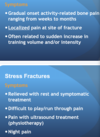Sports Medicine Flashcards
what part of the MSK system serves to protect, store fat cells, blood cell production, and store minerals and ions?
bone
which part of the MSK system is responsible for movement
muscle
which part of the MSK system connects muscle to bone and transfers force from muscle to bone
tendon

which part of the MSK system connects bone to bone, acts as a static stabilizer of joint, and has neurosensory components?

which part of the MSK is wide-spread connective tissue, and envelops muscles, blood vessels, nerves and organs?
fascia
which part of the MSK acts as a synovial-lining od sacs
bursa
function of deepfascai
separates muscle groups

internal, external and inciting risk factors of an MSK injury

risk factors for ACL tear
young age, poor quads, strength, and proprioception, lack of rest.
what is the current program to prevent ACL injury
FIFA 11+. ACL neuromuscular training program is the number 1 way of preventing ACL tears. FIFA 11+ has 15 exercises that involve strengthening, plyometrics and agility, balance activity.
15 exercises: running,
core and leg strength, balance, plyometrics and agility
performed at least 2x/weel
describe how Different types of tissue have different
abilities to heal often based on their
vascularization:
poor: knee minisci and tendon
good: muscle and skin
healing occurs in four broad phases
- bleeding
- inflammatory phase
- proliferation phase
- remodeling phase.
pathophysiology of a stress injury
accumulation of microtrauma from repetitive bone loading. Imbalance of bone remodeling and break-down
Chronic/overuse injury. Imbalance of bone build up vs bone breakdown. The lower extremity bones ar most at risk. Seen in sports with lots of weight bearing like track and field.
Typically present with gradual onset of pain— ont acute pain, but the pain goes from annoying to bad. Might get night pain. US may be painful because it vibrates the bone.
Diagnosed via Tripple phase bone scan. X Ray not usually helpful.
which bone is most affected stress fracture
kiwer extremities most common (tibia and metatarsals)
Any location of the tibia, but most
common at the medial distal 2/3 border Most commonly seen in track and field,
running, dancing and jumping sports
syymptoms of a stress fracture

T/F XRays are helpful to diagnose a stress fracture.
false. usually not helpful– only positive in 10-25% of cases of bone scan positive stress fractures. bone scans are better to do
management of stress fracturs
leg bracing may help and low intensity pulsed US. both aren’t really evidenced based.
overall you can just rest it and gradually go back to exercise.
Gradually increase the load on the bone by running longer distances (of that was their activity. Make sure they’re running with proper footwear. If there is chronic stress fractures, especially in women, think about REDs/malnutrition.

a women with recurrent stress fractures should be screened for:
REDS and malnutrition
What is the “dreaded black line”
an anterior tibia stress fracture. they have a higher rate of delayed union or non-union with 25-60% treatment failure.

what is periostitis. what is it aka?
chronic inflammation of periosteum and adjacent fascia –> periosteal thickening.
aka Medial Tibial Stress Syndrome

symptoms of periostitis;
- usually related to increases in training volume
- less severe with warm-up or if run on softer running surface
- relieved with rest.
- generalized tenderness along length of posterior medial border of the tibia
- palpable focal swelling
- pain with hopping.
It’s pretty hard to differentiate between periostitis and stress fractures. How can you tell the difference?
XR will be normal but triple phase bone scan will show difference.

which one is periostitis? which one is a stress fracture?

periostitis is inflammation of the periosteum surrounding the bone, therefore it isn’t localized to one spot– it’s the entire bone that the affected periosteum is at. therefore, the right one is a periostitis.



